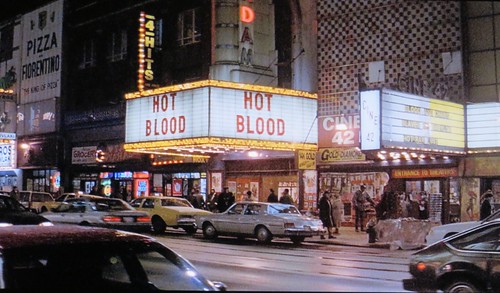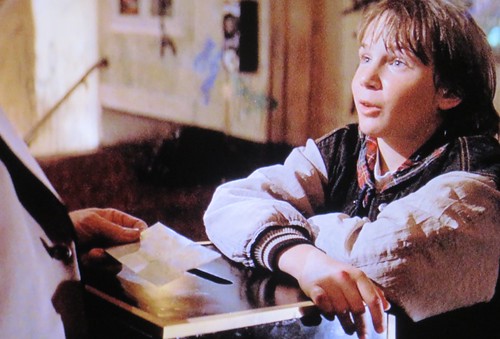42nd Street Theaters
Not long after I started up this blog, I made a point of buying a scanner so I could scan film stills and photos I took in the pre-digital era and put them on this blog. One of the first batches of photos I scanned were those I took on 42nd Street and in Times Square in the 1980s and early 1990s. One group I’m particularly proud of is the series of photos I took sometime in 1992 when Columbia Pictures was shooting LAST ACTION HERO (1993) on the famed strip of 42nd Street theaters between Seventh and Eighth Avenues. All ten theaters then existing on the street were closed at the time and the production team had fixed up the marquees on all of them to look like a typical Deuce lineup from the street’s heyday. (Interestingly, several of the titles featured on the marquees were films that had probably played on 42nd Street once upon a time.)

Photo by Brian Camp, 1992

Photo by Brian Camp, 1992

Photo by Brian Camp, 1992

Photo by Brian Camp, 1992
The Empire Theater, the westernmost marquee on the south side of the street, was chosen to feature the film-within-the-film, JACK SLATER IV, in which the movie’s star, Arnold Schwarzenegger, plays the title character, a fearless gun-toting L.A. cop who shoots first and asks questions later.

Photo by Brian Camp, 1992
The Empire would later lend its façade to the AMC Empire 25, while the actual theater itself would become the lobby of the new multiplex, which opened in 2000 after the original structure had been moved on rollers westward a few yards down the block. In the photo below, taken in 2010, notice the Empire sign on the right just over the AMC 25 Theatres marquee:

Photo by Brian Camp, 2010
I watched LAST ACTION HERO again to remind me how the film itself made use of 42nd Street. I’d forgotten how good this movie is—how witty and funny it was and how cleverly it used film clichés to comment on action movie conventions and the clash between the “real” world and the movie-within-the-movie’s world. It’s about an adolescent boy, Danny Madigan (played by 11-year-old Austin O’Brien), whose love of movies in general and action movies in particular, with a special devotion to Schwarzenegger’s Jack Slater, causes him to frequently cut school and visit a 42nd Street theater where the kindly old projectionist welcomes him and lets him spend all hours there. (The film conveniently ignores the fact that it was never exactly safe for boys that age to visit those theaters alone.) When the projectionist (Robert Prosky) pulls out a “magic ticket” given to him when he was a boy by Harry Houdini himself and uses it to allow Danny to enter the theater for a private pre-opening showing of JACK SLATER IV, the boy soon finds himself magically transported inside the movie and participating alongside the action with his hero, Jack Slater, who has no idea who Arnold Schwarzenegger is. When Danny tries to tell him they’re simply occupying a movie, Slater is completely baffled.
To make a long story short, the villain, Benedict (Charles Dance), eventually gets hold of the magic ticket and uses it to enter the “real” world, coming out into New York’s 42nd Street and a world where criminals blithely rob others and suffer no consequences. He soon determines that he can take advantage of a world where no Jack Slaters exist—until Jack Slater comes through the screen also and pursues him.
The boy’s early visits to the theater where he gets the magic ticket offer a few quick shots of the street, but it isn’t until the characters come out of the movie onto the real street after the long section inside the movie-within-the-movie do we get a series of shots with the tricked-up marquees visible on camera to any significant degree. Given the effort made to spruce up the street for the shoot, I was surprised that so few shots of the marquees made it into the final cut.



The film is full of movie-related gags, including Danny’s trip to a video store inside the movie and his astonishment at seeing an ad for TERMINATOR 2 with Sylvester Stallone in the leading role. Which bothers Danny no end, but not Slater at all. And when F. Murray Abraham shows up in the role of a Fed seeking Slater’s cooperation, Danny is alarmed and warns Slater that “he’s the guy who 𝓀𝒾𝓁𝓁ed Mozart,” referring to Abraham’s role as Salieri in the 1984 Best Picture winner, AMADEUS. (I love the fact that Danny is as familiar with that film as he is with Schwarzenegger’s films.) Danny frequently points out obvious movie conventions, such as the presence of supermodel-gorgeous women working the counter at the video store. (One of them is Angie Everhart.) There’s a steady stream of outrageous characters at the police station, including Whiskers the cat, a cartoon character voiced by Danny DeVito, and, in a bit of acknowledged digital magic, Humphrey Bogart himself:

Best of all, early in the film, when Danny sits in his English class studying Hamlet, he imagines Schwarzenegger in the role and fantasizes an explosive trailer for a Hamlet action movie:
“Something is rotten in the state of Denmark—and Hamlet is takin’ out the trash!”
In the course of it, Hamlet confronts his enemies: “To be or not to be…[pause to light his cigar]…NOT to be.” Blam! The castle blows up behind him. The English teacher shows clips from Laurence Olivier’s version of HAMLET (the 1948 Best Picture winner), a gag given extra cachet by the fact that the teacher is played by none other than Olivier’s real-life widow, Joan Plowright.
And when they all show up in the “real” world it’s just in time for the premiere of JACK SLATER IV, at which the special guest is…Arnold Schwarzenegger! And he’s accompanied by his real life then-wife, the uncharacteristically surly Maria Shriver (did she know something then that we know now?). There’s a brief, but tense interaction between Slater and Schwarzenegger that offers quite a hilarious bit of self-deprecating humor. There are plenty of other cameos throughout the movie, some of them in-jokes like Sharon Stone as her BASIC INSTINCT character; Robert Patrick as his android-impersonating-a-police officer from T2; and Ian McKellen as Death from Bergman’s THE SEVENTH SEAL, and some of them simply as themselves, including Jim Belushi, Jean-Claude Van Damme, Chevy Chase, and Damon Wayans, among others. Melvin Van Peebles (Sweet Sweetback himself) plays an ambulance worker.
It helps that the villain plays it straight throughout and reacts to the “real” world exactly as you’d expect such a villain to react. The most extensive scenes on 42nd Street involve his character.


What really made this film work for me so well was the simple fact that, thanks to Austin O’Brien’s enthusiastic performance, I truly believed that Danny really loved these movies and was beside himself with excitement when he gets to enter one. The joy in his face when he sits down alone in the empty theater for the private premiere of JACK SLATER IV is quite palpable. The kid is happy to be there. And the chemistry between him and Schwarzenegger seems genuine. He reminds me of me when I was that age and going to neighborhood theaters in the Bronx practically every weekend, often alone, to see five-hour double features like THE GREAT ESCAPE and THE MANCHURIAN CANDIDATE.



All of this is in contrast with Martin Scorsese’s HUGO, in which the child actor who plays the title role is scared of everything and everybody and seems completely uninterested in all the things the character is supposed to be interested in, including movies. Danny Madigan is proactive while the kid in HUGO is reactive and even then reluctantly so. Which one would you want to spend an afternoon at the movies with? Interestingly, the connection in HUGO between Hugo and film pioneer Georges Melies echoes the two-degrees-of-separation connection in LAST ACTION HERO between Danny and famed illusionist Harry Houdini, a contemporary of Melies.

The marquee of the Rialto on Seventh Avenue was tricked up as an arthouse to supply a clever gag involving the figure of Death from Bergman’s THE SEVENTH SEAL (1957). Photo by Brian Camp, 1992.